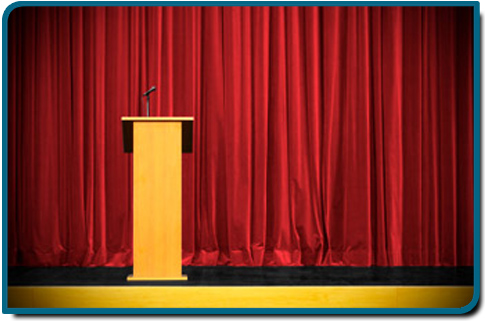FREE
resources
weekly from
Pivotal Public Speaking
View the latest issue here
I will
never give your details to anyone for any reason
|
|
|
|
|
|
Keeping audience Attention

Free Set of Tips on How to grab and keep Audience
attention
Apply for it now!
|
|
Are you a member of Pivotal Gold?
Join
here
Concluding Your Presentation: End With A
Bang, Not With A Whimper.Your conclusion should do much more than
simply tell your listeners that
your presentation is over. Your entire
presentation, in fact, can hinge on the final impression you make. It's that
last impression that can linger the longest. So preparing a strong ending to
your presentation is every bit as important as preparing a strong opening.
A strong opener grabs your audience's attention and leads them to your key
messages; a strong close takes them back to your key messages and brings your
presentation full circle to your ultimate objective.
Plan your conclusion.
Your conclusion is a critical part of your presentation. It's where your entire
presentation is heading. It should bring your presentation full circle to the
objective you've been building towards. It should reinforce your key messages.
It should sound like a conclusion, leaving no doubt that it is a
conclusion. It should add to the positive impression that hopefully you will
have created with your audience.
Conclusions should be short.
Don't ramble. An ending that drags on can actually undo much of the positive
impact of an otherwise good presentation. Once you announce you're about to wind
up, don't go on talking ... and talking.
"you
should be clear about what you want your listeners to feel, think,
and do at the conclusion of your presentation."
|
If it's a call to action, make it crystal clear.
If you're concluding a presentation designed to persuade your audience, your
conclusion should have two key elements: a final call to action based on the
argument you've just made, and a reason to act.
Your call to action should be clear and specific. Your audience should be left
with no doubt about what it is you're asking.
At the same time, you should be clear about what you want your listeners to feel,
think, and do at the conclusion of your presentation. The reason to
act should be framed in terms of what matters to them. So avoid phrases
like "I want you to ..." Instead, for example, if your listeners have
been looking for ways to increase their work productivity, make it clear to them
that your call to action represents an effective way to achieve their goal. Show
them how your call to action serves their interests.
Stay on message.
Be careful not to tuck into your conclusion new ideas or messages that you did
not include in your presentation. That runs the risk of confusing your audience
and obscuring your original messages.
Obvious as it may seem, be absolutely certain that your conclusion extends
logically from everything preceding it. You clearly don't want to offer a
conclusion that's disconnected from the body of your presentation. At the same
time, don't leave out references to a major point you may have made much of in
your presentation.
Make your last impression a lasting one.
People tend to recall best what they hear last. So prepare and rehearse your
conclusion with special care. Consider how you can make your conclusion
memorable both in substance and delivery.
Use some of the techniques from the successful presenter's toolbox. Consider,
for example, combining intonation, pauses-and especially, to-the-point phrases
that are likely to stay with your audience. Jack Welch, in his early days as CEO
of General Electric, faced head-on the need for radical changes in the company's
business direction. He would often end meetings with a simple call to the
company's employees: "Change ... before you have to." The message
behind that sound bite was unmistakable, and eventually resonated throughout the
company. It was perhaps the best and most successful summation of Welch's
business philosophy.
Speak or read?
It's usually better to speak your conclusion without reading it. If you're more
comfortable using notes, put them in bullet form, listing the main ideas and
messages you want to reiterate and reinforce from your presentation. Keeping
your eyes focused on your audience instead of your notes is always helpful, the
more so when your conclusion is a call to action.
When your presentation is followed by Q-&-A's.
If a Q-&-A session follows your presentation, don't stop talking when the
questions are done. Have a strong finishing flourish ready as your final
statement. Your best summation, however brief, should be the last thing your
listeners hear. You can repeat your closing statement or re-phrase it,
underscoring your key message one final time.
For more on how to conclude your presentations read our article on Grand
Finales.
| Executive
Communications Group
Want your next presentation to be a home run? Learn how to plan,
design and deliver your next presentation to make it a winner. Attend
our popular presentation skills seminar and start getting the results
you want. |

|
|


